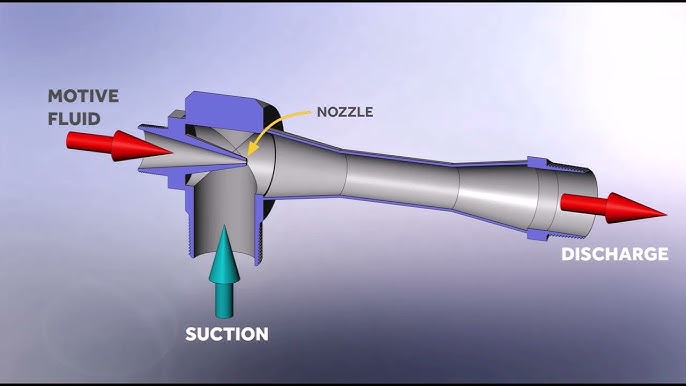As you navigate the intricate systems aboard a ship, you may come across the term “eductor” and wonder about its significance. This unassuming device plays a vital role in fluid management at sea, but how exactly does it function, and what makes it indispensable for maritime operations? Let’s explore the intricacies of this essential component and unravel its impact on ship performance and safety.
History of Eductors
The history of eductors dates back to the 19th century when they were first utilized in marine applications. The invention timeline of eductors can be traced to the early 1800s when engineers sought efficient ways to move fluids on ships.
Initially designed as simple devices, eductors evolved over time to become more sophisticated and effective in various industries.
In the mid-1800s, the design evolution of eductors saw improvements in materials and shapes, allowing for better fluid dynamics and increased efficiency.
As steam power became more prevalent on ships, eductors were adapted to utilize steam as the driving force, enhancing their performance and versatility.
How Eductors Work
To understand how eductors work, it’s essential to grasp the fundamental principles governing their operation. Eductors operate based on the principles of fluid dynamics, utilizing the Venturi effect to create a vacuum that draws in fluid or material.
The Venturi effect is a phenomenon where the pressure of a fluid decreases as it flows through a constricted section of a pipe, causing the fluid velocity to increase.
In the case of eductors, a high-pressure fluid is passed through a nozzle, creating a high-velocity stream. This high-velocity stream passes through a Venturi-shaped section, which leads to a decrease in pressure, generating a vacuum that draws in another fluid or material from a lower-pressure source.
The two fluids then mix and exit the eductor at a different pressure and velocity.
Understanding these eductor principles and the application of fluid dynamics is vital for comprehending how eductors effectively operate in various systems on ships.
Types of Eductors
Within the domain of fluid dynamics and industrial applications, various types of eductors are employed to facilitate fluid mixing, pumping, and conveying processes efficiently.
When it comes to eductors, there are specific types designed to suit different needs. Here are the types you may encounter:
- Steam Eductors: These eductors use high-pressure steam as the driving fluid to create a vacuum for pumping liquids, granular solids, or slurries. They’re commonly used in industries requiring efficient pumping operations.
- Ejector Pumps: Ejector pumps utilize a high-velocity motive fluid to entrain and mix with the suction flow, effectively pumping out the desired substance. They’re known for their simplicity and reliability in various applications.
- Air Eductors: Operating similarly to steam eductors but using compressed air instead, air eductors are favored for their versatility in handling different types of fluids and materials.
- Multi-Stage Eductors: These eductors are designed with multiple stages to provide enhanced vacuum generation and pumping capabilities, making them suitable for demanding industrial tasks requiring high efficiency.
Applications in Maritime Industry
Amidst the vast expanse of the maritime industry, eductors find essential application in facilitating fluid transport and pumping operations aboard ships. One significant application is in fuel transfer processes. Eductors play an important role in transferring fuel from storage tanks to engines, providing an efficient and reliable method for ensuring a continuous fuel supply to power the vessel’s operations.
Another critical application of eductors in the maritime industry is in bilge pumping. Eductors are utilized to pump out bilge water from the lower compartments of the ship, helping to maintain a safe and stable vessel by preventing water accumulation.
Maintenance and Troubleshooting
In maintaining eductors on a ship, guaranteeing proper functionality is vital for the seamless operation of fluid transport systems.
To uphold the efficiency of eductors, it’s important to follow specific maintenance procedures and troubleshooting techniques:
- Regular Inspections: Conduct routine checks to inspect for any signs of wear and tear, corrosion, or blockages in the eductor system.
- Cleaning Procedures: Implement a systematic cleaning schedule to prevent clogging and guarantee peak performance of the eductors.
- Testing Mechanisms: Periodically test the eductor system under various operating conditions to verify functionality and identify any potential issues.
- Documentation and Record-Keeping: Maintain detailed records of maintenance activities, repairs, and any troubleshooting undertaken to track the performance of the eductors over time.
Frequently Asked Questions
Are Eductors Environmentally Friendly?
In evaluating the environmental impact of eductors, consider their operational efficiency. They are generally considered environmentally friendly due to their minimal energy consumption and ability to utilize existing resources effectively, thereby reducing waste.
What Materials Are Eductors Typically Made Of?
When designing eductors, materials like stainless steel, bronze, or PVC are common choices due to their durability and resistance to corrosion. These materials are essential for optimizing eductor efficiency and ensuring long-term performance on ships.
Can Eductors Be Used for Firefighting on Ships?
Yes, eductors can be used for firefighting on ships. They are efficient at extinguishing fires by drawing in water or foam concentrate, mixing it with the motive fluid, and generating a powerful stream to combat fires effectively.
Are Eductors Easy to Install on a Vessel?
Installing eductors on a vessel is straightforward. Consider maintenance needs during the installation process. Guarantee proper fittings and connections. Regularly check for wear and tear. Follow manufacturer guidelines for ideal performance and safety at all times.
Do Eductors Require Any Special Certifications for Use on Ships?
To operate eductors on ships, certification requirements must be met. Confirm adherence to operational guidelines for safe usage. These guidelines dictate proper installation, maintenance, and usage to assure peak performance and compliance with maritime regulations.





